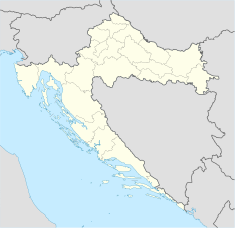Castle Rotondo
| Castle Rotondo | |
|---|---|
| Native name Croatian: Dvorac Rotondo | |
 | |
| Location | Kaštel Štafilić, Dalmatia, Croatia |
| Coordinates | 43°32′51″N 16°20′08″E / 43.547553°N 16.335450°ECoordinates: 43°32′51″N 16°20′08″E / 43.547553°N 16.335450°E |
| Area | Kaštel Štafilić |
| Built | 1508 |
 Location of Castle Rotondo in Croatia | |
Castle Rotondo is a fortress castle in Kaštel Štafilić, Croatia, on the Adriatic coast. It was fully constructed in 1508, on the order of Stefano Štafileo, a Trogirian nobleman. Stafileo ordered its construction in 1508 to protect his lands and the Kozjak's peasants from the Ottomans pillaging. It is situated by a beautiful sea cliff.[1]
Parallel to the castle, there is a fortified renaissance house, where there is the Stafileo's family crest, engraved with a bunch of grapes. The grapes are a visual translation of the Štafileo name, which means bunch of grapes in Greek. The crest symbolizes wine making, and the future. There is also an inscription in Latin above the castle gate, which states the original purpose behind the Castle's construction. The southern residential wing of the house has a water gate that still exists today.[2]
Origin of the name[]
Castle Rotondo is named after the noble family, 'Rotondo' that resided in it for over 400 years.[3] Prior to this, it was 'Castle Štafileo'.
History[]
The first owner, and builder, Stefano Štafileo arrived from Crete, Greece, and married a woman from Trogir. He became a well-respected resident of Trogir with houses and residences all over town.
Stefano's son was Bishop of the diocese of Sibenik, Archdiacon in Trogir, a doctor in law, lecturer in Rome, the papal legate, diplomat, Croatian Latinist, and later, Polish nobility.
Ivan was a diplomat to Pope Leo X, handled the divorce of King Henry VIII of England, and Catherine of Aragon. Was baptized by the French king Francis I in 1519. The King of Poland, Sigismund I the Old, gave Ivan a title, and a priceless painting. The painting can be found today in the church of Kaštel Štafilić.[3]
Function[]
The Castle functioned as a Fortress, where it protected villagers from invading Turkish occupiers.[3]
Size[]
The Castle has an area of 1,127 m2, with a ground floor, and three higher floors,[4]
References[]
- ^ "Kaštel Štafilić - Castle Rotondo - Split and Dalmatia County Tourist Board". Dalmatia.hr. Retrieved 9 February 2017.
- ^ "Kastel Stafilic, Croatia - Croatia View - Best Croatian Destinations". Croatia View. Retrieved 9 February 2017.
- ^ a b c "Kaštela: 25 Things to Know About the City of Castles, Tragic Lovers and Homeland of Zinfandel". Total-croatia-news.com. Retrieved 9 February 2017.
- ^ "Kaštil Rotondo za 2 500 000 eura - Portal grada Kaštela". Kastela.org. Retrieved 9 February 2017.
- Castles in Croatia
- Buildings and structures in Split-Dalmatia County
